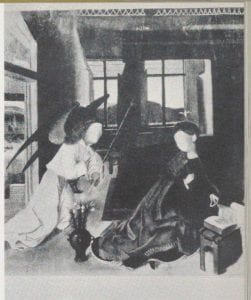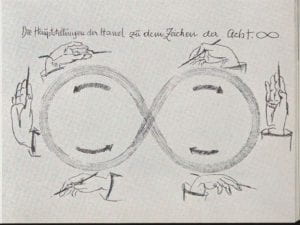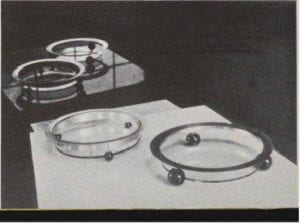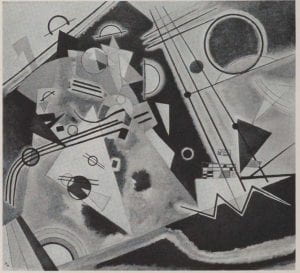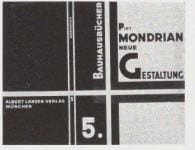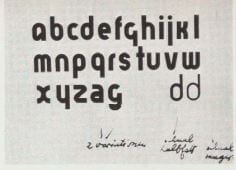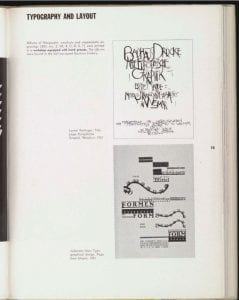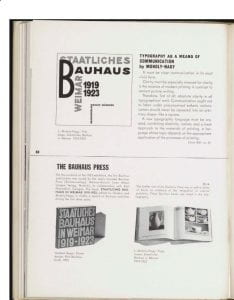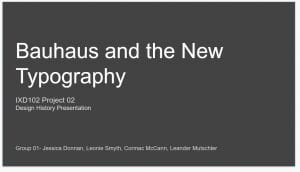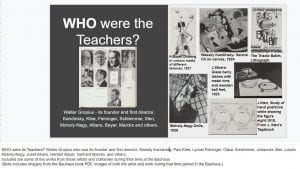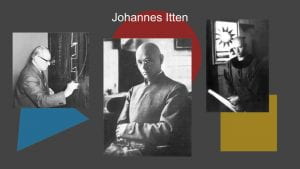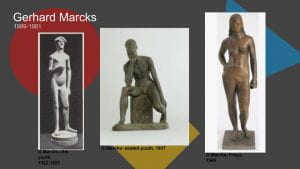Brief – Develop a Design History Presentation based on one of the following titles;
- Bauhaus and the New Typography
- Design Systems for the Olympic Games
- The Influence of Modern Art
- The Modern Movement in America
- Pioneers of Postmodern Graphic Design
- Pioneers of Web/ Digital Design
‘In your groups you will deliver a ten minute presentation based around one of the titles. Presentations will be delivered in Week 08; Friday 13th November 2020’
My Group – Jessica Donnan, Leonie Smyth(me), Cormac McCann, Leander Mutschler
After discussing the brief with my group we decided on the topic – Bauhaus and the New Typography. We all decided to come back with relevant research to the Bauhaus and the New Typography, to then work towards more specific research i.e. artists and areas we are individually interested in.
Research
Below is the research I gathered throughout the research period
The Bauhaus and the New Typography
What was the Bauhaus?
The Bauhaus was a state-sponsored initiative to integrate the artist and the craftsman whilst bridging the gap between art and industry. Founded by Walter Gropius in Weimar Germany with the idea of creating a total work of art in which all arts: painting, sculpture, graphic design photography, architecture, industrial design and typography, all would eventually be brought together. The Bauhaus style became one of the most influential movements in modern architecture and modern design.
The Bauhaus curriculum combined theoretic education and practical training in the educational workshops. It drew inspiration from the ideals of the revolutionary art movements and design experiments of the early 20th century,
Notes extracted below from book reference; Bauhaus, 1919-1928
WHAT is the Bauhaus?
The Bauhaus is an answer to the question: how can the artist be trained to take his place in the machine age?
HOW did the Bauhaus idea begin?
As a school which became the most important and influential institution of its kind in modern times.
WHERE?
In Germany, first at Weimar, then at Dessau.
WHEN?
From 1919 until closed by the National Socialists in 1933.
WHO were its teachers?
Walter Gropius, its founder and first director, Kandinsky, Klee, Feininger, Schlemmer, Itten, Moholy-Nagy, Albers, Bayer, Breuer, and others.
WHAT did they teach?
Architecture, housing, painting, sculpture, photography, cinema, theatre, ballet, industrial design, pottery, metal work, textiles, advertising, typography, and above all, a modern philosophy of design.
WHY is the Bauhaus so important?
- Because it courageously accepted the machine as an instrument worthy of the artist.
- Because it faced the problem of good design for mass production.
- Because it brought together on its faculty more artists of distinguished talent than has any other art school of our time.
- Because it bridged the gap between the artist and the industrial system.
- Because it broke down the hierarchy which had divided the “fine” from the “applied” arts.
- Because it differentiated between what can be taught (technique) and what cannot (creative invention).
- Because its building at Dessau was architecturally the most important structure of the 1920’s.
- Because after much trial and error it developed a new and modern kind of beauty.
- And, finally, because its influence has spread throughout the world, and is especially strong in England and the United States.
The Bauhaus at Dessau
In 1925 the Bauhaus was moved from the hostile Weimar to hospitable Dessau. By this time, a new generation of teachers had been trained, each of whom was at once a creative artist, a craftsman and industrial designer, and the dual system of instruction could be abandoned. New ideas began to flow forth in abundance, and from the Bauhaus of this period derive many familiar adjuncts of contemporary life- steel furniture, modern textiles, dishes, lamps, modern typography and layout. The spirit of functional design was carried in into the “fine arts” and applied to architecture, city and regional planning. But to speak of a cut and dried “Bauhaus style” would be to revert to the cultural paralysis of the 19th century with its “free styles.” Its integral part, namely the functional foundation of design, was just as full of changing possibilities as our own “technical age.” We believe that we have only glimpsed the great potentialities of this technical age, and that the Bauhaus idea has only begun to make its way.
WHO were the teachers?
During the war, some vacancies occurred on the staffs of the two schools (the Academy of pictorial art and the Academy of arts and crafts) which Gropius later United in the Bauhaus. This enabled him to have three masters appointed at the very beginning: Johannes Itten, Lionel Feininger and Gerhard Marcks in May 1990. They were joined later by Adolph Meyer, 1919 – 1920, Paul Klee, January 1921, Oskar Schlemmer, April 1921, was Wassily Kandinsky, June 1922, and Laszlo Moholy–Nagy, 1923. Replacement of certain members of the old staff, who did not fit into the new educational line at the Bauhaus, led to bitter controversy with the older generation of artists and Weimar.
Where did the students come from?
The students of the Weimar Bauhaus came from all over Germany, north and south, and from Austria. They were from 17 to forty-years old, most of them in their early twenties. Two thirds of them were men, half of whom had served in the army during the last years of the great War. Most of the students had to earn a living, and Gropius therefore persuaded the Weimar Ministry of education to cancel tuition fees. Furthermore, he managed to give some financial support to those students who produced saleable goods in the Bauhaus workshops.
Workshops- Bauhaus
Workshops that took place at the Bauhaus were a mix of artistic practise and industry practise. These included workshops in carpentry, stained glass, pottery, metal, weaving, stage and wall painting.
Courses that took place at the Bauhaus were taught by artists and craftsmen who were either masters in their own field or even previous students of the Bauhaus. The Preliminary course was taught over time by Johannes Itten, Josef Albers and Maholy-Nagi. Wassily Kandinsky and Paul Klee both ran their own courses during their time at the Bauhaus.
Kandinsky’s course looked at Constructional and Linear Analysis whereas Klee’s course looked at Active, Intermediate and Passive Factors of different working systems.
carpentry workshop
stained glass workshop
pottery workshop
metal workshop
weaving workshop
stage workshop
wall painting workshop
Workshops – Dessau
furniture workshop
metal workshop: lighting fixtures
weaving workshop
wall painting workshop: wallpaper
sculpture workshop
stage workshop
typography workshop: printing, layout, posters
Courses- Bauhaus
preliminary course: Itten
preliminary course: Moholy-Nagy
preliminary course: Albers
klee’s course
kandinsky’s course
Courses- Dessau
Preliminary course- Albers
Preliminary course- Maholy- Nagy
Kandinsky’s course
Other Areas- Bauhaus
Display Design
Architecture
Typography and Layout; the Bauhaus Press
Colour experiments
Other Areas-Dessau
Photography
Exhibition Techniques
Painting, Sculpture, Graphic Art, 1919- 1928
Dessau Bauhaus 1925-1928
Faculty and Students
Almost all of the former masters, Feininger, Groupius, Kandinsky, Klee, Moholy-Nagy, Muche, Schlemmer, remained with the Bauhaus when it moved to Dessau. Gerhard Marcks, however, went to teach near Halle since there was not money or room to reinstall his ceramics workshop in Dessau. Five former students, Josef Albers, Herbert Bayer, Marcel Breuer, Hinnerk Scheper, Joost Schmidt, were appointed masters, and nearly all of the Bauhaus students moved from Weimar to Dessau, where work was immediately begun in provisional quarters.
The New Curriculum
The curriculum underwent several changes; joint instruction by a craftsman and an artist was abandoned. Therefore, each workshop was directed by one master. The department of architecture was considerably enlarged and the teachers at the Municipal School cooperated with it. A department of typography and layout was added, The principles of the Bauhaus were again clarified; The Bauhaus is an advanced school for creative work.
Its purpose is:
- The intellectual, manual and technical training of men and women of creative talent for all kinds of creative work, especially building
- The execution of practical experimental work, especially building and interior decoration, as well as the development of models for industrial and manual production.
A business organisation, the Bauhaus Corporation, was established to handle the sale to industry of models created in the Bauhaus workshops.
Visual Research
Below is the visual material I gathered throughout doing my research which was included throughout the presentation.
WHO were the teachers at the Bauhaus? – The teachers’ photo profiles and examples of their work that they completed during their time at the Bauhaus.
Photos were taken from book reference- ‘Bauhaus 1919-1928’.
Workshops and Courses at the Bauhaus – Photos were taken from book reference- ‘Bauhaus 1919-1928’.
The move from Weimar to Dessau – Newspaper clippings, found this a nice visual to show how much the media then documented this change, Photos were taken from book reference- ‘Bauhaus 1919-1928’.
Workshops and Courses at the Bauhaus after the move – what stayed the same and what changed. Photos were taken from book reference- ‘Bauhaus 1919-1928’.
Other Book pages that I screenshotted and found helped informed my written research. All content taken from book reference – ‘Bauhaus 1919-1928’.
Slide Designs
Below are the slide designs so far, as the Bauhaus was in the time period between 1919-1933, I decided to stick to a black, white and grey theme to suit this time period and this accommodated well to the visual imagery as all imagery put into the slides so far are from a black and white book reference.
Tutor Feedback – Week 07-Friday 06th November 2020
Below are the select slides that are finished to date. After talking to Kyle in our group rooms, he recommended to add simple shapes to the design, like the iconic primary colour shapes, circle, square, triangle, red, yellow and blue. We decided to try this as a general pattern and slightly adjusted it each slide. We agreed as a group that this style suited this slides as this design did come out of the Bauhaus. I decided whilst playing about with the designs to try one shape and colour and repeat it as seen in the slides ‘A Fresh Beginning’ and ‘Workshops and Courses at Dessau’. After doing this discussing with the group we decided to keep this design as a break design . So it would only be incorperated in specific slides to break up the original pattern.
Final Slide Designs
Speaker notes
Slide 6 – The Bauhaus curriculum combined theoretic education and practical training in their workshops. It drew inspiration from the ideals of the revolutionary art movements and design experiments of the early 20th century.
The course of instruction at the Bauhaus was divided into two parts: instruction in crafts and instructions in form problems.
Each area within Instruction in Crafts were different workshops, for examples stone was the Sculpture workshop.
Instruction in form problems covered Observation, Representation and Composition.
Observation looked at the study of nature and the analysis of materials. Representation looked at descriptive geometry, technique and drawing of plans and building models for all kinds of construction. And Composition looked at the theory of space, colour and design.
Slide 7 – The workshops at the Bauhaus were a mix of artistic practise and industry practise. These included workshops in carpentry, stained glass, pottery, metal, weaving, stage and wall painting.
Courses that took place at the Bauhaus were taught by artists and craftsmen who were either masters in their own field or previous students of the Bauhaus . The Preliminary course was taught over time by Johannes Itten, Josef Albers and Laszlo Maholy-Nagi. Wassily Kandinsky and Paul Klee both ran their own courses during their time at the Bauhaus.
Kandinsky’s course looked at Constructional and Linear Analysis whereas Klee’s course looked at Active, Intermediate and Passive Factors of different working systems.
Slide 9 – The Transition from Weimar to Dessau was due to the mounting pressure from the nazi party and the Thuringia government that caused the initial closure of the Bauhaus. The work created in the bauhaus school was seen as disfigured art by influentual figures and a movement that challenged the nazi party.
With a large request for the continuation of the Bauhaus from architecture and art societies and newspapers, the school was relocated to Dessau.
Slide 10 – This was the newly constructed bauhaus school in dessau which was a stark contrast to the traditional conservative buildings dessau consisted of.
Slide 32– Gerhard Marcks was a German artist, known mostly for his sculptures but also known for his graphic work, woodcuts and ceramics. Marcks was one of the first appointed masters in the Bauhaus teaching the Pottery workshop. Above are some examples of some of his early sculptures he crafted in his years as a sculptor.
When researching the Bauhaus and looking at all the works from that time period I found Marcks work to stand out to me especially his woodcuts.
Slide 33– Above are three woodcut prints that Marcks had created during his time at the Bauhaus. I like these pieces as they are a good mix of graphic and traditional. His use of singular lines and block shapes give them that bold graphic element, but at the same time the line placement gives a detailed and more defined look which still gives the traditional media aspect to his work.
Slide 34 – In 1931 the Nazi party dominated the Dessau City Council; it cancelled Bauhaus faculty contracts in 1932. Mies van der Rohe tried to run the Bauhaus from an empty telephone factory in Berlin-Steglitz, but Nazi harassment made continuance untenable.
The Gestapo demanded the removal of ‘cultural Bolsheviks’ from the school, with Nazi sympathizers as replacements. The faculty voted to dissolve the Bauhaus, and it closes on 10 August 1933, with a notice to students that faculty would be available for consultation if needed.
Thus ended one of the most important design schools of the 20th Century.
Presentation Reflection
I think the delivery of the presentation went well, everyone in the group spoke well and were prepared for each slide. I think I spoke properly and quite clear, I think I also was well prepared for the delivery of the presentation with multiple run throughs done both with the group and on my own as well as having speaker notes ready on the day. I think the design of the presentation was executed to good standards with the blue, yellow and red triangle, square and circle pattern working consistently throughout the slides. The layout was well presented with changes being made after tutorial suggestions which helped the layout be more spacious and presented both imagery and information in a good visual manner. I think again as a group we did well with the amount of information found for the presentation and executed it well throughout the presentation without going to much over, even though we did go over time slightly. Same comment with my individual research and ideas that I brought to the group as I found I did a fair amount of research for the presentation as well as everyone else. Overall I believe both as a group and individually the presentation was researched, designed and delivered appropriately and to good standards of work. If I were to do the presentation again I would definitely time the presentation a bit better as we did go over the 10 minute mark when presenting.


